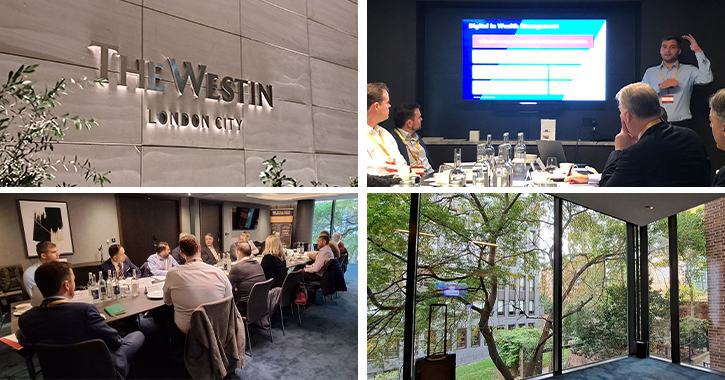This Heads of Wealth briefing in London saw Dorsum share expertise on how technology is shaping the future of wealth management, looking specifically at how wealth managers can utilise client portal usage data to power their business.
James Goad, Managing Director at Owen James opened the session with a look at how wealth and asset managers are trying to keep up with tech in order to attract new clients and strike the right balance of client engagement.
A live poll revealed how attendees around the table felt concerned about the new regulations in the FCA Consumer Duty Act and not very comfortable with the digital solutions they are currently offering clients. Based on their client’s feedback, the areas that need improving their digital offering are as follows:
- User experience – 29.03%
- Functionality – 19.35%
- Engagement – 19.35%
- Education – 16.13%
- Self-service capabilities – 12.9%
Afterwards, Keith MacDonald, Senior Advisor Wealth Management at EY set out the current digital state of the industry, before inviting attendees to share their experiences.
- Up until 2019, 80/90% of budgets were being spent on the regulatory changes and to remove the issues, rather than business change
- Then followed a massive swing towards client-facing technology from 2020-2021, which needed to be planned more strategically, but there are as many technical architectures as wealth managers
- Innovation with client-facing infrastructure is increasing, but so are concerns over the cloud’s use of data
- It is key to look through the client’s perspective, but CEOs tend to only see from the organisational side
- How you use the tools to support clients with the difficult conversations they are having, chart this and try and predict what will happen next is a key challenge
Ákos Szalay, Head of Product – Wealth Portal presented Dorsum’s answers to wealth manager’s key challenges:
- Clients expect the same convenience they are used to, but WM firms shouldn’t compete with big tech because these companies aim for a mass market
- WMs need to focus on both the digital and the face-to-face experience.
- Tech companies use MVPs to address just one need of their client. Once you can see what your clients are doing you can adjust the functionalities which will boost your client engagement
- After you have specified your MVP, you can focus in on 3 or 4 of the most important functionalities and build the digital roadmap before adding data capabilities which allow you to see what the client is doing, how they are behaving differently and how best you can assure them you are there
- The client portal will then drive many new conversations and questions which in turn increases the amount the clients get in touch with their advisers
Dorsum also shared key findings about communication preferences between clients and advisers, including automated chats with bots, citing Hungarian language versions as an example of the importance of having multiple languages for a bot when dealing with a large international client base (as part of tender 2018-1.1.2-KFI-2018-00006, “Hungarian language recognition, comprehension and reproduction as a chatbot service on multiple platforms”).
Finally, the guests invited discussed the questions raised at the round table discussion. There was talk of the implementation possibilities of digital innovation, the satisfaction of the unique needs of the customers, and the possible bridging of generational differences. We also heard about the importance of personal interactions in digital innovation and the specifics of different markets (USA, UK, Europe).
We learned that after the “covid era”, customers find personal meetings important again. According to what has been said, one of the biggest challenges is to define exactly what we want to build with the help of our tech specialists. Since communication between departments is often difficult, as a result, a product from an excellent environment does not always match customer needs.

Project 2018-1.1.2-KFI-2018-00006 has been realised with the support of the Ministery of Innovation and Technology’s Research and Innovation Fund, through the 2018-1.1.2-KFI tender programme.




